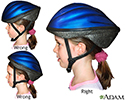Bicycle safety
Many cities and states have bike lanes and laws that protect bicycle riders. But riders are still at risk of being hit by cars. Therefore, you need to ride carefully, obey the laws, and watch for other vehicles. Always be prepared to stop or take evasive action.
While riding your bicycle:
- Watch for opening car doors, potholes, children, and animals that may run in front of you.
- Do not wear headphones or talk on your cellphone.
- Be predictable and ride defensively. Ride where drivers can see you. Bicycles are frequently hit because drivers did not know the bikes were there.
- Wear brightly colored clothing so that drivers can easily see you.
Obey the rules of the road.
- Ride in the same direction as the flow of traffic.
- At intersections, stop at stop signs and obey traffic lights as cars do.
- Check for traffic before turning.
- Use correct hand or arm signals.
- Stop first before riding out into a street.
- Know the law in your city about riding on the sidewalk. In most cities, bicyclists older than 10 must ride in the street. If you must be on the sidewalk, walk your bike.
The brain is fragile and easily injured. Even a simple fall can cause brain damage that may leave you with lifelong problems.
When riding a bike, everyone, including adults, should wear helmets. Wear your helmet correctly:
- Straps should be snug underneath your chin so the helmet will not twist around your head. A helmet that flies off will not protect you or your child.
- The helmet should cover your forehead and point straight ahead.
- Do not wear hats underneath your helmet.
Your local sporting goods store, sports facility, or bike shop can help make sure your helmet fits properly. You can also contact the American League of Bicyclists.
Throwing around bicycle helmets can damage them. If this happens, they will not protect you as well. Be aware that older helmets, passed down from others, may not still offer protection.
Make Sure You Can be Seen at Night
If you ride at night, try to stay on roads that are familiar and brightly lit.
The following equipment, required in some states, will keep you safer:
- A front lamp that shines a white light and can be seen from a distance of 300 feet (91 m)
- A red reflector that can be seen from the rear at a distance of 500 feet (152 m)
- Reflectors on each pedal, or on the shoes or ankles of the bicyclist, that can be seen from 200 feet (61 m)
- Reflective clothing, tape, or patches
Riding With Infants
Having infants in bike seats makes the bike more difficult to manage and harder to stop. Accidents that occur at any speed can injure a young child.
Following some simple rules can help keep you and your child safe.
- Ride on bike paths, sidewalks, and quiet streets without much traffic.
- Do not carry infants younger than 12 months on a bike.
- Older children should not carry infants on a bike.
To be able to ride in a rear mounted bike seat or child trailer, a child must be able to sit without support while wearing a lightweight helmet.
Rear-mounted seats must be securely attached, have spoke guards, and have a high back. A shoulder harness and a lap belt are also needed.
Safety Tips for Children
Young children should use bikes with coaster brakes. These are the kind that brake when pedaled backward. With hand brakes, a child's hands should be large enough and strong enough to squeeze the levers.
Make sure bikes are the right size, rather than a size "your child can grow into." Your child should be able to straddle a bike with both feet on the ground. Children cannot handle oversize bikes and are at risk of falling and other accidents.
Even when riding on sidewalks, children need to learn to watch for cars pulling out from driveways and alleys. Also, teach children to watch for wet leaves, gravel, and curves.
Make sure your child is careful about keeping loose pants legs, straps, or shoelaces from getting caught in the spokes of the wheel or bicycle chain. Teach your child never to ride barefoot, or while wearing sandals or flip-flops.
References
Centers for Disease Control and Prevention website. Bicycle safety. www.cdc.gov/transportationsafety/bicycle/index.html. Updated November 2, 2020. Accessed December 6, 2021.
HealthyChildren.org website. Bicycle safety: myths and facts. www.healthychildren.org/English/safety-prevention/at-play/pages/Bicycle-Safety-Myths-And-Facts.aspx. Updated November 21, 2015. Accessed December 6, 2021.
National Highway and Traffic Safety Administration website. Bicycle safety. www.nhtsa.gov/road-safety/bicycle-safety. Accessed December 6, 2021.
Review Date: 8/10/2021
Reviewed By: Neil K. Kaneshiro, MD, MHA, Clinical Professor of Pediatrics, University of Washington School of Medicine, Seattle, WA. Also reviewed by David Zieve, MD, MHA, Medical Director, Brenda Conaway, Editorial Director, and the A.D.A.M. Editorial team.


